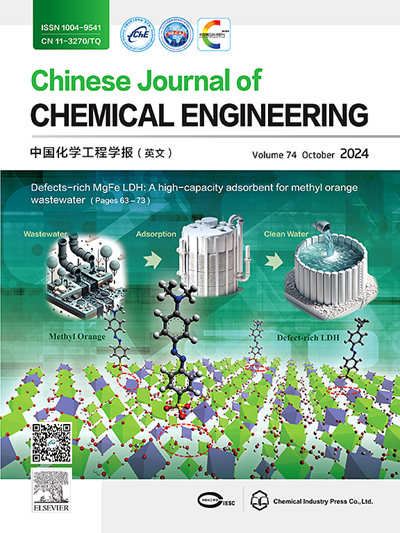CPAM-assisted synthesis of NaA zeolite membrane on macroporous mullite hollow fiber for ethanol dehydration by pervaporation
IF 3.7
3区 工程技术
Q2 ENGINEERING, CHEMICAL
引用次数: 0
Abstract
Due to the low transport resistance, mullite hollow fiber (HF) could be regarded as a promising support for preparation of NaA zeolite membranes. However, insufficient coverage and undesired seed penetration often occur in the seeding step of the mullite support due to the rough surfaces with ultra-large macropores (2–4 μm). This leads to poor intergrowth of the membrane layer. To solve this issue, cationic polyacrylamide (CPAM) was employed to modify the chemical and electrostatic properties of the mullite HF surface, where the electrostatic attraction between the surface and seed crystals could significantly promote the coating effect. In the seeding, the original seeds (3.2 μm) were mixed with the ball-milled seeds (0.3 μm) to improve the seed coverage, i.e., the original seed was used to block the macropores on the support surface to prevent the penetration of small seeds, while the decked ball-milled seed was used to provide sufficient active sites to induce the intergrowth of the zeolite crystals. The effects of the concentration of CPAM, mixed mass ratio of seeds, and seed concentration on the preparation of NaA zeolite membranes were systematically examined, where the separation performances were characterized by pervaporation (PV) dehydration of 90% (mass) ethanol/water mixtures at 75 °C. The results indicated that under a CPAM concentration of 0.7% (mass), an equivalent mass ratio of mixed seeds in a seed concentration of 1.0% (mass), the prepared mullite HF supported NaA zeolite membrane yielded the best PV performance, where the permeation flux and separation factor corresponded to 5.45 kg·m−2·h−1 and 10000, respectively, being sufficient for industrial applications.

cpam辅助在大孔莫来石中空纤维上合成NaA沸石膜用于乙醇的渗透蒸发脱水
莫来石中空纤维具有较低的传输阻力,是制备NaA沸石膜的理想载体。然而,由于莫来石支架表面粗糙且具有超大孔径(2 ~ 4 μm),在播种阶段往往会出现覆盖不足和种子穿透不理想的情况。这导致膜层的不良共生。为了解决这一问题,采用阳离子聚丙烯酰胺(CPAM)改性莫来石HF表面的化学和静电性能,其中表面与种子晶体之间的静电吸引力可以显著提高涂层效果。在播种过程中,将原始种子(3.2 μm)与球磨种子(0.3 μm)混合,以提高种子的覆盖度,即原始种子用于堵塞支撑表面的大孔,防止小种子的渗透,而覆盖的球磨种子用于提供足够的活性位点,诱导沸石晶体的共生。系统考察了CPAM浓度、种子混合质量比和种子浓度对NaA沸石膜制备的影响,并对90%(质量)乙醇/水混合物在75℃下的渗透蒸发(PV)脱水性能进行了表征。结果表明,在CPAM浓度为0.7%(质量),混合种子质量比为1.0%(质量)的条件下,制备的莫来石HF负载NaA沸石膜的PV性能最佳,其渗透通量和分离系数分别为5.45 kg·m−2·h−1和10000,足以满足工业应用。
本文章由计算机程序翻译,如有差异,请以英文原文为准。
求助全文
约1分钟内获得全文
求助全文
来源期刊

Chinese Journal of Chemical Engineering
工程技术-工程:化工
CiteScore
6.60
自引率
5.30%
发文量
4309
审稿时长
31 days
期刊介绍:
The Chinese Journal of Chemical Engineering (Monthly, started in 1982) is the official journal of the Chemical Industry and Engineering Society of China and published by the Chemical Industry Press Co. Ltd. The aim of the journal is to develop the international exchange of scientific and technical information in the field of chemical engineering. It publishes original research papers that cover the major advancements and achievements in chemical engineering in China as well as some articles from overseas contributors.
The topics of journal include chemical engineering, chemical technology, biochemical engineering, energy and environmental engineering and other relevant fields. Papers are published on the basis of their relevance to theoretical research, practical application or potential uses in the industry as Research Papers, Communications, Reviews and Perspectives. Prominent domestic and overseas chemical experts and scholars have been invited to form an International Advisory Board and the Editorial Committee. It enjoys recognition among Chinese academia and industry as a reliable source of information of what is going on in chemical engineering research, both domestic and abroad.
文献相关原料
公司名称
产品信息
阿拉丁
sodium hydroxide
 求助内容:
求助内容: 应助结果提醒方式:
应助结果提醒方式:


